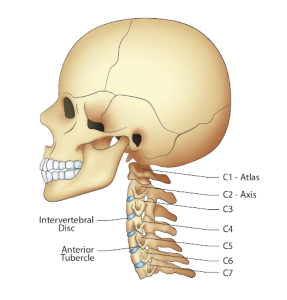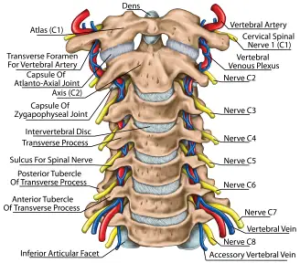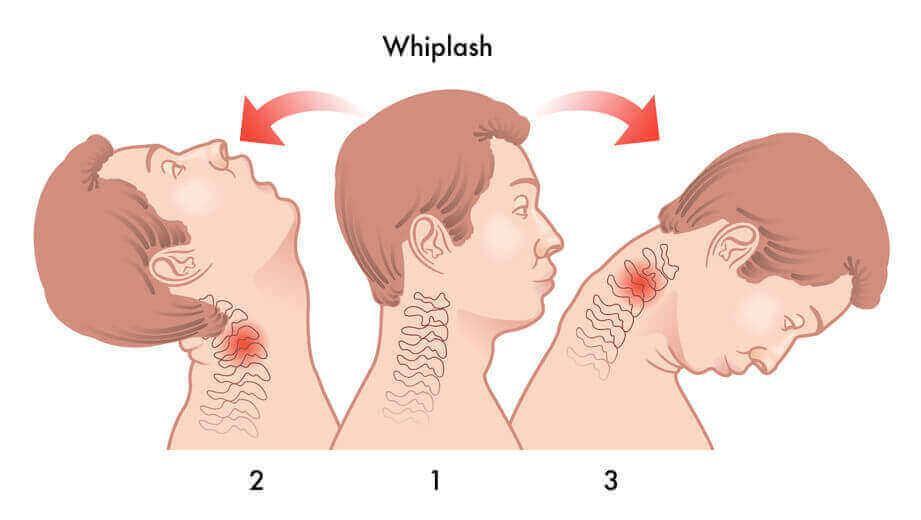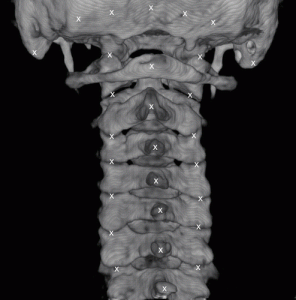Introduction
Neck pain can be more than a discomfort; for some, it manifests with an unexpected companion – dizziness. This perplexing duo often points to a condition known as cervical vertigo. In this comprehensive blog, we will delve into the intricacies of cervical vertigo, exploring the cervical spine, its role in vertigo, symptoms, treatment options, and practical insights for living with this challenging condition.
Understanding the Anatomy and Function of Cervical Spine

The cervical spine, often referred to as the neck, is a section of the vertebral column located in the upper part of the spine. It consists of seven vertebrae labeled C1 to C7, with each vertebra uniquely designed to fulfill specific functions. These vertebrae are smaller and more mobile than those in other regions of the spine, allowing for the intricate movements crucial for daily activities.
The primary function of the cervical spine is to provide support for the head, which houses the delicate brain and serves as the command center for the entire body. The first cervical vertebra, known as the atlas (C1), cradles the skull, allowing for the nodding motion, while the second vertebra, the axis (C2), facilitates the pivotal motion needed for rotation.
Additionally, the cervical spine is instrumental in supporting the weight of the shoulders and facilitating movements such as tilting, turning, and bending. This flexibility is essential for activities ranging from simple tasks like looking over one’s shoulder to more complex movements involved in activities like driving, sports, and day-to-day chores.
Network of Blood vessels and nerves in the cervical region
Beyond its role as a structural support, the cervical spine is a hub for a complex network of nerves and blood vessels that intricately weave through its bony framework. Nerves stemming from the spinal cord within the cervical spine extend to various regions of the body, serving as messengers for communication between the brain and peripheral organs.
The cervical nerves are responsible for controlling and coordinating various bodily functions, including muscle movements, sensation, and reflexes. For instance, the nerves branching from the cervical spine contribute to the motor control of the arms and hands, allowing for precise movements and dexterous tasks.

Accompanying this neural network are blood vessels that supply oxygen and nutrients to the spinal cord and surrounding tissues. The vertebral arteries, which run through the cervical vertebrae, are vital conduits ensuring a continuous flow of blood to the brain. This intricate vascular network plays a critical role in maintaining the health and functionality of the nervous system.
What Causes Cervical Vertigo/ Cervicogenic Dizziness ?
Cervical vertigo, often synonymous with cervicogenic dizziness, constitutes a perplexing fusion of cervical spine dysfunction and the manifestation of dizziness. To decipher this phenomenon, it is imperative to delve into the intricacies of how dysfunction within the cervical spine can trigger a cascade of events leading to a sensation of vertigo.
The cervical spine, housing a myriad of nerves and blood vessels, serves as a vital conduit for communication between the brain and the rest of the body. When this communication pathway is disrupted due to various factors, it can result in a mismatch of sensory input, leading to a sense of imbalance and dizziness. For example, misalignments or structural abnormalities in the cervical vertebrae can impinge on nerves, sending conflicting signals to the brain about the body’s position in space.
Furthermore, degenerative changes within the cervical spine, such as arthritis or disc-related issues, can compromise the stability of the spine and contribute to abnormal sensory feedback. As a consequence, the brain may struggle to reconcile the conflicting signals from the cervical region, giving rise to dizziness. Decoding cervicogenic dizziness involves unraveling this intricate web of neurological and biomechanical interactions, understanding how disruptions within the cervical spine can reverberate throughout the body and induce a sense of disequilibrium.
Common Triggers for Cervical Vertigo: Examining Potential Causes
- Neck Injuries : Traumatic incidents, such as whiplash from a car accident or a fall, can inflict damage to the cervical spine. Injuries to the ligaments, muscles, or vertebrae can disrupt the delicate balance within the neck, setting the stage for cervicogenic dizziness.
- Degenerative Changes : As the body ages, the cervical spine undergoes natural wear and tear. Conditions like cervical osteoarthritis or degenerative disc disease can alter the structural integrity of the spine, compromising its ability to transmit accurate sensory information.
- Misalignments : Abnormalities in the alignment of the cervical vertebrae, whether due to congenital factors or acquired postural issues, can lead to nerve compression and altered proprioception. These misalignments create a discord between the signals sent to the brain, contributing to the onset of dizziness.

What Are the Symptoms of Cervical Vertigo?
Cervical vertigo, a complex interplay of cervical spine dysfunction and dizziness, manifests a spectrum of symptoms that can significantly impact an individual’s daily life. This section delves into the hallmark symptoms of cervical vertigo, shedding light on the intricate relationship between neck pain and dizziness, while also exploring associated symptoms that provide a nuanced understanding of this challenging condition.
Neck Pain and Dizziness – Hallmark Symptoms
- Neck Pain : Individuals experiencing cervical vertigo often report varying degrees of neck pain, ranging from a dull ache to sharp, stabbing sensations. The neck pain is typically localized to the cervical spine region, emphasizing its connection to the underlying dysfunction within the neck.
- Dizziness : Concurrent with neck pain, individuals may experience episodes of dizziness characterized by a sensation of spinning, imbalance, or a general feeling of lightheadedness. This dizziness is often triggered or exacerbated by specific neck movements, further emphasizing the intimate relationship between cervical spine dysfunction and the onset of vertigo.
Associated Symptoms – Additional Manifestations
Beyond the central duo of neck pain and dizziness, cervical vertigo may present with a constellation of associated symptoms that provide a more comprehensive understanding of its impact on an individual’s well-being. These associated symptoms further contribute to the diagnostic puzzle, offering insights into the multifaceted nature of cervicogenic dizziness.
- Headaches : Cervical vertigo often coexists with headaches, which may manifest as tension-type headaches or migraines. The relationship between neck pain, dizziness, and headaches underscores the interconnectedness of the cervical spine, sensory input, and pain perception.
- Visual Disturbances : Visual disturbances, such as blurriness or difficulty focusing, can accompany cervical vertigo. These disturbances may be exacerbated by head movements, highlighting the intricate interplay between the cervical spine, visual processing, and the body’s spatial awareness.
- Balance Issues : Individuals with cervical vertigo may experience challenges with balance, especially during activities that involve head movements. This further underscores the impact of cervical dysfunction on the body’s proprioceptive feedback and coordination.
What Is the Treatment for Cervicogenic Dizziness?“
Cervicogenic dizziness, a condition born from the intricate dance of dysfunction within the cervical spine, demands a nuanced and comprehensive approach to treatment. This section unravels the therapeutic strategies aimed at alleviating cervical vertigo symptoms, embracing both holistic methodologies and targeted interventions to restore equilibrium.
Holistic Approach to Relief – Multifaceted Treatment“
Holistic treatment for cervicogenic dizziness transcends a singular focus, recognizing the interconnectedness of the body’s systems and the need for a comprehensive approach. This multifaceted strategy encompasses various modalities, including physical therapy, exercises, and lifestyle modifications.
Holistic Approach to Relief – Multifaceted Treatment“
- Physical Therapy : A cornerstone of holistic treatment, physical therapy aims to restore optimal function to the cervical spine. Therapists employ targeted exercises and manual techniques to address muscular imbalances, improve range of motion, and enhance overall neck stability.
- Exercises : Tailored exercises play a pivotal role in strengthening the muscles supporting the cervical spine. These exercises often focus on improving posture, enhancing proprioception, and promoting stability, contributing to a more resilient and balanced neck. These exercises aim to recalibrate sensory input, enhance balance, and reduce the frequency and severity of dizziness episodes.
- Lifestyle Modifications : Lifestyle adjustments form an integral part of holistic relief. Educating individuals on ergonomic practices, stress management, and maintaining a healthy lifestyle can mitigate triggers and contribute to the overall well-being of the cervical spine.
- Cervical Spine Manipulation : Hands-on techniques, such as cervical spine manipulation performed by qualified healthcare professionals, aim to realign the cervical vertebrae and alleviate nerve impingements. This targeted intervention seeks to restore normal biomechanics and reduce symptoms of dizziness.
- Medications : In certain cases, medications may be prescribed to manage symptoms such as pain or vestibular disturbances. Medications may include muscle relaxants, pain relievers, or medications to address underlying conditions contributing to cervical vertigo.
Role of Prolotherapy in managing Cervical Vertigo“
Areas covered under fluoroscopic cervical prolotherapyCervical vertigo, characterized by dizziness and imbalance stemming from dysfunction within the cervical spine, poses unique challenges for individuals seeking relief. Among the array of therapeutic options, prolotherapy emerges as a promising and comprehensive approach to address the underlying causes of cervical vertigo and promote long-term restoration of function. This essay delves into the principles, mechanisms, and potential benefits of prolotherapy in the context of cervical vertigo.

Principles of Prolotherapy“
Prolotherapy, short for proliferative therapy, is a regenerative injection technique designed to stimulate the body’s natural healing processes. The core principle of prolotherapy involves the injection of a solution, often containing a combination of dextrose (a type of sugar), local anesthetic, and other substances, into targeted areas of the body. This solution initiates a controlled inflammatory response, activating the body’s repair mechanisms.
Mechanisms of Action“
In the context of cervical vertigo, prolotherapy operates through several key mechanisms
- Ligament and Tendon Strengthening : The solution injected during prolotherapy serves to stimulate the growth and strengthening of ligaments and tendons in the cervical spine. This is particularly relevant in cases where ligament laxity contributes to instability.
- Reducing Inflammation : By inducing a controlled inflammatory response, prolotherapy helps modulate chronic inflammation in the cervical spine. Inflammation is a common factor in conditions associated with cervical vertigo, and addressing it is pivotal for symptom relief.
- Promoting Tissue Repair : The injection triggers the release of growth factors, encouraging the repair and regeneration of damaged tissues. This is especially beneficial in addressing degenerative changes within the cervical spine.
- Enhancing Stability : Prolotherapy contributes to improved stability in the cervical spine by promoting the growth of strong, supportive connective tissues. This enhanced stability can mitigate the aberrant signaling that contributes to vertigo.
Benefits of Prolotherapy for Cervical Vertigo“
- Targeted and Precise Treatment : Prolotherapy allows for precise targeting of the affected areas in the cervical spine, ensuring that the therapeutic effects are concentrated where they are needed most.
- Minimally Invasive : As a non-surgical intervention, prolotherapy is minimally invasive compared to more aggressive surgical options. This makes it a favorable choice for individuals seeking relief without the inherent risks and downtime associated with surgery.
- Holistic Approach : Prolotherapy aligns with a holistic approach to healing by addressing the root causes of cervical vertigo. Rather than merely alleviating symptoms, it aims to promote comprehensive restoration of function.
- Long-Term Effects : While multiple sessions of prolotherapy may be required, the regenerative nature of the treatment sets the stage for long-term relief. By promoting tissue repair and strengthening, prolotherapy offers sustained benefits beyond the immediate post-injection period.
Living With Cervicogenic Dizziness: Strategies for Well-being“
Living with cervical vertigo necessitates a proactive approach to lifestyle choices that promote overall well-being and resilience. By integrating practical tips into daily life, individuals can empower themselves to manage symptoms effectively.
- Posture Awareness : Cultivating awareness of posture is pivotal for those with cervical vertigo. Maintaining a neutral neck position, avoiding prolonged periods of neck flexion or extension, and ensuring ergonomic setups can contribute to reduced strain on the cervical spine.
- Stress Management : Stress can exacerbate symptoms of cervical vertigo. Incorporating stress management techniques such as deep breathing exercises, meditation, or mindfulness can create a sense of calm and minimize triggers associated with heightened stress levels.
- Regular Exercise : Engaging in regular, low-impact exercises is crucial for maintaining overall health and managing symptoms. Activities such as walking, swimming, or gentle yoga can enhance cardiovascular fitness, promote muscular strength, and contribute to improved balance.
Seeking Support – Building a Resilient Support Network“
Acknowledging the challenges of living with cervical vertigo, seeking support becomes an integral aspect of fostering resilience and well-being. This involves reaching out to various sources of support, including healthcare professionals, support groups, and loved ones.
- Healthcare Support : Establishing an open line of communication with healthcare professionals is crucial. Regular check-ins with physicians, physical therapists, or specialists ensure that treatment plans are tailored to evolving needs, fostering a collaborative approach to managing cervical vertigo.
- Support Groups : Joining support groups provides a platform for individuals with cervical vertigo to share experiences, insights, and coping strategies. The sense of community within support groups fosters understanding and solidarity, offering emotional support on the journey.
- Loved Ones : The support of family and friends plays a pivotal role in navigating the challenges of cervical vertigo. Open communication about symptoms, needs, and preferences ensures that loved ones can provide meaningful support and understanding.
CONCLUSION
Encouraging individuals to actively seek support acknowledges the importance of a comprehensive network in the holistic management of cervical vertigo. By fostering connections with healthcare professionals, engaging in support groups, and leaning on the support of loved ones, individuals can navigate the complexities of living with cervical vertigo with greater resilience and a sense of community.
In essence, the treatment landscape for cervicogenic dizziness is a tapestry woven with both holistic principles and targeted interventions. By embracing a comprehensive approach that addresses the multifaceted nature of cervical spine dysfunction, individuals can embark on a journey toward relief, resilience, and restored equilibrium. As always, consultation with healthcare professionals such as at Alleviate Pain Clinic, ensures personalized and effective strategies for managing cervicogenic dizziness based on individual circumstances.





